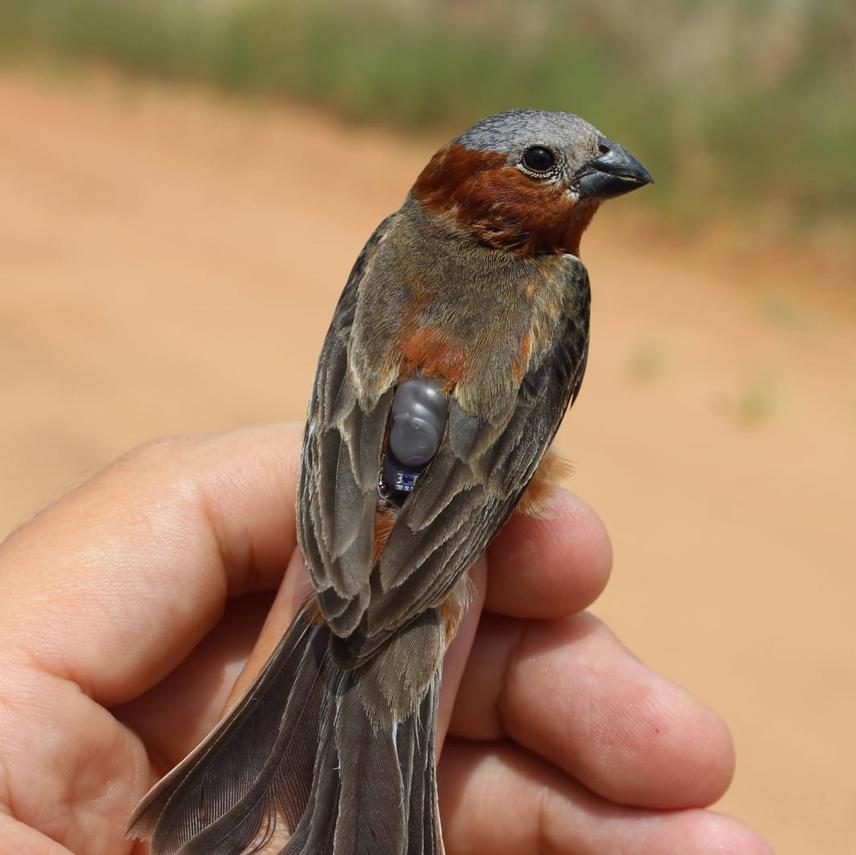Jonas Rafael Rodrigues Rosoni
Chestnut Seedeater Sporophila cinnamomea is classified, by BirdLife International, as “Vulnerable” owing to a rapid population decline caused by trapping for the bird trade and extensive habitat loss. It breeds in the Pampas region of southern South America and spends the non-breeding season in the Cerrado of central Brazil. However, the species’ biology, migration routes, and contranuptial sites are poorly understood. Our goal is to gain understanding on Chestnut Seedeater’s breeding biology and migration to identify critical areas for its conservation; furthermore, we want to raise awareness for a fascinating species that lives in two threatened, South American grasslands.

Geolocator fixed to a male individual of Chestnut Seedeater (Sporophila cinnamomea).
Sporophila seedeaters form one of the few groups of Neotropical birds for which breeding biology is well-studied; however, there are still poorly understood, issues. An example of a poorly-researched species is Chestnut Seedeater S. cinnamomea, which breeds in the Pampas grasslands of southern South America and presumably spend nonbreeding season in the Cerrado of Central Brazil. Chestnut Seedeater is globally “Vulnerable” to extinction due to extensive habitat loss and illegal bird trade. Nevertheless, unlike other seedeaters, little is known about its breeding biology, migration routes, and nonbreeding areas. Therefore, we have decided to investigate the breeding biology and migration of Chestnut Seedeater’s to fill gaps in scientific knowledge important for the species’ conservation.
In the next two years, we will carry out fieldwork in two areas of Pampas region in western Rio Grande do Sul and in two areas within the Cerrado Biome in Central Mato Grosso do Sul. Species migration will be studying using light level geolocators. Besides fieldwork, the team will develop Chestnut Seedeater’s distribution models, including land use and occupation variables, among others. With this, we expect to quantify percentages of:
(1) grassland remnants,
(2) grasslands converted into farmlands
(3) ecological corridors (i.e. areas of vegetation connecting isolated grasslands and wetlands),
(4) the proportion of the species range included in the protected areas.
Essentially, our project has been thought to directly fulfil at least goals of the Brazilian National Action Plan (NAP) for the conservation of threatened grasslands birds, namely,
(1) to carry out detailed studies on species’ habitat selection, demography, breeding biology, and migration;
(2) to gather information on the biology of birds that, in future, may be used as a protocol in managing captive breeding.
Furthermore, our data will also be helpful in achieving at least other two goals of the National Action Plan:
(1) creating protected areas in western Rio Grande do Sul,
(2) developing a program of environmental education, aiming to increase the general public’s knowledge and awareness of grasslands birds and their habitats. This latter goal will be approached by us through education activities at schools and community events and training inspectors working directly with illegal trapping in Rio Grande do Sul.
Header: Detail of the leg loop harness in the geolocator in detail.